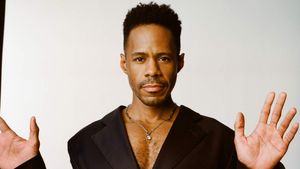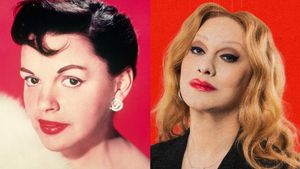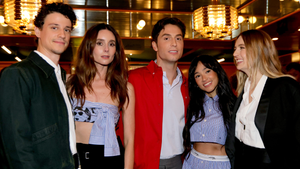Artistic director, Katy Pyle, and co-teacher and dancer, Jules Skloot, are longtime collaborators who are challenging the gender binary in dance by reimagining classic tales from the ballet canon in a way that centers lesbian, queer, and transgender people. The aptly named New York City dance company, Ballez, offers adult dance classes that teach classic ballet movements in an environment that encourages queer gender play. The company is simultaneously preparing for the April 29th premiere of Sleeping Beauty & the Beast at LaMaMa Experimental Theater Club.
Sleeping Beauty & the Beast will feature a diverse cast of 23 dancers, with selections of Tchaikovsky’s classic score played live by the Queer Urban Orchestra, and original house music by JD Samson. The scope of the project, Pyle admitted during our interview, is huge. “We’re pressing right up against the limits of possibility,” she said. “But it is important for me to show that queer artists can do something that is big, that is grand, and that is celebratory—that we don’t have to be kept in tiny cabaret stages, shut away from the bigger world.” In order to accomplish their grand, celebratory production while keeping ticket prices at an accessible $35 or less, Ballez launched a Kickstarter campaign (that ends 18 days from the time of publication) with a goal of $25,000.
I talked to Jules Skloot and Katy Pyle about their roles with the company, their favorite moments from the forthcoming show, and how art and activism intersect at Ballez.
PRIDE: How would each of you describe your roles at Ballez, and on Sleeping Beauty & the Beast?
Katy Pyle: I’m the artistic director of the Ballez. I’m directing the show, fundraising for it, and getting it out into the world. And I’m not performing in this show…
Jules Skloot: Which is different. She usually is. I’ve been collaborating with Katy for about six-ish years, so before the Ballez formally came to be. I collaborated on the choreographic creation of some of the work, and on the story and other details. I’m playing the role of The Beast in this production.
PRIDE: How did you decide on this story, and what should people know about the periods of history it covers?
KP: The Sleeping Beauty ballet has always been something that really stuck in my mind. It was probably the first ballet I saw live when I was 12-years-old, and I thought it was really magical. The ballerina that was playing Princess Aurora broke her ankle in the middle of the show, and then the other dancer came out still dressed as The Lilac Fairy, but she just took over the role and became Aurora, which was extremely strange. But I was like, 'That’s amazing! The wrong person is doing this role, but she is the right person.' I think there was something formative for me about that particular experience, and how I think about dance—how I think about being the right person in the wrong costume, or the wrong role—that somehow translates a little bit into this work.
The Sleeping Beauty premiered in 1890. I chose to set this story in 1893 in a garment factory on the Lower East Side, because in 1893 the United Garment Workers of America had their first major 16,000 person strike. I was kind of linking up The Sleeping Beauty story with the Industrial Revolution, and the industrialization of spinning. Spinning wheels factor pretty heavily into The Sleeping Beauty story, so I wanted to draw a parallel there, and think about the women that tried to create more fair labor conditions at that time, and celebrate a history that is a little bit more neglected.
Then we chose 1993, because it’s 100 years later. Initially, I was thinking about the visibility of lesbians in 1993—k.d. lang being shaved by Cindy Crawford on the cover of Vanity Fair, and the first New York Dyke March being in 1993. There was a lot of movement toward visibility for lesbians at that moment. Then, as we got more into the research, and Jules and I talked to people that were in New York at that time, we realized that the AIDS pandemic was still a major part of everybody’s life, especially in New York in the queer community. That was having a big effect on how lesbians and queer people were visible. That’s a big part of the second act of our show.
PRIDE: You’re also going outside between Act I and Act II for a street protest scene. What are your thoughts on bringing queer art out into public spaces?
KP: I’ve been really moved by being part of marches and protests, especially in the past several years, and I feel like it’s a really beautiful important moment, a live moment. You can take a picture, but it doesn’t necessarily capture the feeling of it. Which is also why I think dance is a really special form—it can contain feeling and emotion, and it’s something you can experience live in real time. I feel like using that form of dance on the street in a more visible way is a way of celebrating and connecting to that experience of actually being at a protest. Although, (laughs) I don’t know. It’s a very choreographed, abstracted situation. It’s not a historical reenactment.
JS: It also, to me, feels connected to the activists of 1993—the people who were blending art and activism at that time. People were really putting their politics and their personal identities into the art they were creating. So, it feels like a kind of homage to that moment. The personal is political, and all that.
PRIDE: How do you see art and activism coming together in your own work?
KP: Maybe because I did grow up in an era where the personal was political, when that notion was kind of in the air, I feel like there is so much interconnection between art making, politics, and activism. To me, art has the power to express what we really believe in, to make visible representations of our values. That’s what motivates me to make work. I feel very strongly about the way that different people are oppressed, or are kept out of being a part of things, and I feel very deeply about my own experience of being pushed out of the ballet world. I want to make space for people where they do feel like they can be part of things, and can feel noble in their bodies, and see themselves reflected.
JS: Dance as live performance is so radical, because we’re in this moment of people being pretty profoundly isolated and doing a lot of activism from their own living rooms or in disenfranchised and cut off places. What’s so wonderful about performance is that it’s people coming together physically in time and space and, like a protest, that’s tremendously powerful.
PRIDE: In terms of physically coming together in a specific space, could you talk about the significance of the La MaMa theaters where you’re premiering, and what it means to perform Sleeping Beauty & the Beast there?
KP: We are really lucky and excited to be in the La MaMa Moves! dance festival. The curator, Nicky Paraiso, is someone that I’ve known since I was very young and first moving to the city. He’s supported queer art for his entire career, and he’s just a great person. La MaMa, as an institution, has supported radical and queer art for decades. The theater we’re performing in has hosted a lot of really tremendous people. There’s just been a really wonderful lineage of queer performance in that theater. Our first act is in the Ellen Stewart Theater. Ellen Stewart is the woman who founded La MaMa, and she was a really wonderful, radical thinker.
JS: We’re also very excited because it’s in such close proximity to where the narrative of our story takes place.
KP: Right, so you’re pretty much on the Lower East Side, and that’s the setting of our story. The theater also looks like a factory, and we’re not really changing anything about the space. It creates a perfect set. So, after we go out and witness this street protest, we go downstairs into the basement theater, which feels so much to me like early 90s dyke clubs in the same neighborhood, and we create this feeling that the whole audience is entering another time and another place.
PRIDE: That’s really cool. I wish I’d had the opportunity to go to one of those basement clubs.
JS: Totally!
KP: I know. Well, you can come to our show!
PRIDE: There are probably a lot of queer audience members who are interested in Ballez performances that aren’t necessarily interested in going to classical ballets. What do you think draws people to your shows, and what references will they understand that a straight audience member might not get?
KP: There are a lot of jokes in Sleeping Beauty & the Beast… like the fairies, who are gay men that work for the garment factory, give Aurora the gifts of fingering, boundary making, and gender fluidity, as opposed to like, beauty and grace.
JS: The evil witch [Carabosse] is recast as the dyke cousin who reads astrology.
KP: She reads the baby’s chart, and that’s how she predicts that she’s going to fall in love with a union-organizing dyke with a spinning wheel. She’ll prick her finger, be kissed by this woman with a spinning wheel, and fall madly in love.
Ballet is an exciting potential form to connect to more audiences because this classical ballet uses a fairy tale, which is not just in the realm of ballet. It’s a fairy tale that a lot of people have heard of at some point, and they have a relationship to that story. We’re playing with a lot of reference points that will hopefully offer more people an entry point into the world. There are a lot of jokes that queer people especially will connect to, but we also want to invite straight people to come to the show. We want to invite people to the show who care about queer people, or who care about having a broader representation of their own genders, and what it means to be a human that is not limited by a gender binary in terms of what you can do and how you can act. We’re really playing with that within the choreography, especially through partnering; there are smaller feminine people lifting and supporting bigger masculine people.
PRIDE: Jules, what moments do you dance in Sleeping Beauty & the Beast that really stand out to you? What are you really excited for people to see?
JS: My character is The Beast in 1993, but a union organizer in 1893. Tchaikovsky’s music is pretty incredible, and in the music that we’re using for the scene where the union organizer is trying to organize the other factory workers is the Rose Adagio. It just gets super exciting, and majestic, and loud, and I get to do these really big, sweeping, gestural movements that are trying to draw people in and incite people.
I can think of other moments, but I also have another thought to share. You asked why [this story] Sleeping Beauty & the Beast, and Katy gave you a lot of information about The Sleeping Beauty, but I wanted to bring in the Beauty & the Beast aspect of the story. When the project was in its baby stages, I remember Katy and I both reading this queer retelling of Beauty & the Beast that was really playing with gender, playing with mixing up who was the beauty and who was the beast, and overlaying those characters as being the same person. It was a really beautiful queer reclaiming of what is considered by society to be beastliness as actually something that people just don’t have the lens to see for what it really is, which is beauty. That idea is in every Ballez—recasting people in these roles that are, to a straight audience, surprising, or unfamiliar, or even upsetting. But then we really center the whole project on affirming the beauty of these people.
PRIDE: Why should somebody support this project on Kickstarter even if they can’t go out and see it?
JS: Because art is good, and this is a good project! It deserves to be in the world. All of these dancers deserve to be paid for their hard work. Even if you don’t get to see it now, it contributes to these ideas growing, to other people being able to see it—and it’s that kind of rippling out of ideas and experiences that changes things.
KP: Ultimately, I feel like we’re creating representation here. Whether or not people get to come to the show, we’re entering the ballet cannon. We’re creating something that can be documented, remembered, talked about, and viewed in pictures or videos. It can show young dancers that there are alternatives that I didn’t see when I was a thirteen-year-old dancer in 1993. I want to make more space for young people, and old people, and people in all parts of their lives to think, 'I can be different than what I’ve been led to believe. I can be in my body in a way that feels authentic to me. I can be in a relationship with other people in a way that feels authentic to me.' Like Jules was saying, it has a ripple effect on other people and hopefully on the society.
PRIDE: For those who do get to see the show, what can they expect, and what should they be excited about?
KP: I mean, there’s gonna be an orchestra! There are going to be 23 beautiful dancers that have a wide range of gender identities, and presentations, and different types of bodies, and different types of dancing. There’s beautiful lighting design and costumes. The street protest! You get to time travel 100 years in this show.
JS: I also think people can expect and be excited about the balance of reverence and irreverence that Katy was talking about before. There is truly genuine heart and humanity shining through, with lots of humor, and joy, and fun at the same time.
For more information about Ballez, visit their website or Kickstarter. Photos courtesy of Elyssa Goodman.























































 Sapphic outlaw moviesNew Line Cinema; A24; Samuel Goldwyn Company
Sapphic outlaw moviesNew Line Cinema; A24; Samuel Goldwyn Company



















 35 bisexual pop anthems we have on constant repeatYouTube.com/Binoy
35 bisexual pop anthems we have on constant repeatYouTube.com/Binoy
 Kirkam/Shutterstock
Kirkam/Shutterstock











